コラム
落合憲弘
John Sypal
タカザワケンジ
なぎら健壱

(左)長野・軽井沢 1982年 ©︎SUDA ISSEI Works
(右)静岡・三島 1984年 ©︎SUDA ISSEI Works
Suda Issei’s passing in March of 2019 was a somber moment for photography in Japan- rare is it for any photographer to demonstrate an eye as keen as his for as long or as well as he did. Soon after, Mark Pearson, publisher of several of Suda’s magnificent books, wrote a touching tribute (https://zen-foto.jp/en/blog/article-interview/in-memory%EF%BD%9Cissei-suda) reflecting on his experiences with the photographer. In it, he asks a question which I feel is at the core of any encounter with his work.
What is it that is so satisfying about a Suda photograph?
That sense of satisfaction- the richness, the qualities of mystery exposed- there is something inherent and so “right” in a Suda photograph. It’s difficult to put into words but in his essay Pearson notes that their simplicity is the starting point. This “simplicity” isn’t “easy”, or empty, but rather, “simple” as in absolute. In Suda’s photographs we feel able to see the truest essence of a subject. Simply the right time, the right place. The right moment. This is a task which is terrifically difficult to accomplish- Suda Issei, however, seemed able to do so with every single push of the shutter button.
Despite being known primarily for working in monochrome, Suda’s archives also contain his richly fascinating color work- series of photographs which were showcased regularly in camera magazines from 1979 and beyond. FUJIFILM has generously brought one such series, Landscape of Japan, Margins of the City, back to light in an excellent exhibition at their Photo History Museum in Tokyo Midtown. “Satisfying” only begins to describe it.
The photographs in this series were taken around Japan from 1982 to 1986, with 43 images first exhibited at Fuji Photo Salon Professional Space in Ginza in 1986. The 2022 show features 32 pictures, new lambda color prints made with his original film. This printing style preserves the lush richness of Suda’s precise use of color positive film- the buttery reds in particular gleam with such vitality that it’s hard to look away.
Approaching the exhibition wall, I was first struck by the images’ coherent beauty seen from a distance. Seeing so many of his pictures at once like this is a fascinating experience. Standing a few meters away, the array of the panels pull you in. One by one, with thoughtful inspection his photographs suggest a shift past the surface of our daily world- through it and we’re given glances at what the Fujfilm’s text suggests is a “dual reality”. The longer you ponder any of them, the more captivating they become.
And the photographs themselves?
They are all undoubtedly, classic Suda. In these squares are menageries of vibrant street signage, odd juxtapositions, expressions of people at attention or lost in thought, and strangely captivating street debris- how can empty bottles and a half-eaten apple be so alluring? Yet only a single image, a woman in a lustery crimson dress, shows straightforward, “decisive” movement / moment. All of the rest each capture a moment of stillness. Even when a person is shown, say, a woman crouching sideways to take a low-angle photo in Asakusa, or a woman leaning along a sea wall, they are caught at a crest of in-between, non-action. What came next after the photos is never quite suggested- each moment remains so perfect in its square and time that it feels that it always has existed, and will exist in this form.
Suda’s interest went beyond the just subjects in front of his lens- the work in this show demonstrates the depth of his interest in experimenting with the photographic medium itself- a game- one played with alterations of time which are impossible for the human eye to see in our “real”. This includes his sublime use of flash, or- and sometimes with- long exposures. These “invisible” realms are casually mixed in with images made from more straightforward approaches. Suda’s use of time, shown slow and fast, is captured in the blurred billowing of sakura petals and decorative cloth in April: the real suggests the unreal. The mysterious splendor in his work is in part created as our mind tries to make sense of things which we know should feel “normal”, but here ever so slightly, do not.
The exhibition’s subtitle states that these photographs of the “margins” of the urban environment- these margins are less geographical than they are mental. Perhaps what drives the work are the gaps between our understanding and expectations and feelings between our expectations for this world, and the worlds shown in Suda’s pictures.
The exhibition statement on Fujifilm’s website includes this wonderful passage:
- Thinking about photography around the clock, Suda kept taking pictures as he walked the streets, never letting go of his camera even for an instant, shamelessly and reflexively pressing the shutter. He did not look like a professional photographer, but like someone possessed by photography, someone whose whole body had become a camera. He had become “a camera on two legs.”
It’s at first difficult to decide whether Suda is a guide or an explorer. A guide suggests a planned tour of predictable sights to see. The risks evident in Suda’s use of non-traditional balance of light and time suggest to me that he was exploring the medium- and, undoubtedly fascinated by what he and his camera had snipped out from the fabric of our reality. As this approach picks up steam it surpasses mere enjoyment and deepens to a personal exploration for meaning. The loop-like process of photography- shooting, editing, printing, seeing- gives a dedicated photographer, one consumed by the magic of photography, sustenance to deal with the world. There’s always something to be seen, either on paper, or, like Suda, camera in hand, out in the margins of our world.
「Suda Issei:The Camera on Two Legs」 is an exhibition well worth your time and attention- as of this writing I have already been twice. Since it is generously up until December 28th, 2022, I plan on making several more trips back to see more. Highly recommended.
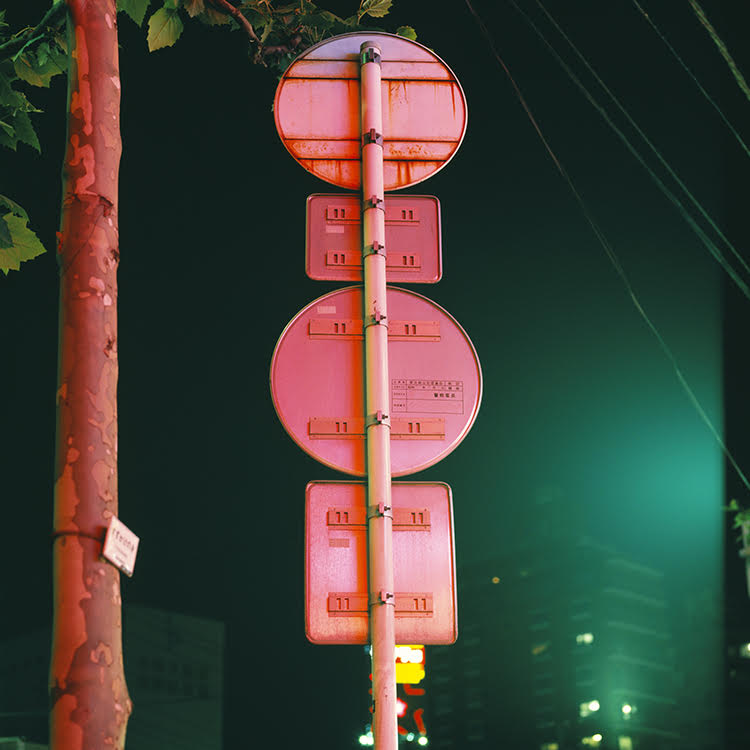
東京 1983-1986年 ©︎SUDA ISSEI Works
2019年3月、須田一政の逝去は日本の写真界にとって厳粛な出来事でした。彼のような鋭い目が、あれほどまで長く、あれほどまでうまく発揮できる写真家は滅多にいないのです。
没後直後、須田氏の素晴らしい写真集の数々を出版してきたマーク・ピアソン氏が、写真家との経験を振り返った、感動的な追悼文を書きました。
https://zen-foto.jp/jp/blog/article-interview/in-memory|issei-suda
その中で、須田氏の作品との“出会いの核心”であると感じられる質問を投げかけています。
須田一政の写真の満足度とはなんなのだろう?
その満足感、豊かさ、神秘性。
須田氏の写真に内在している何かについて言葉にすることは難しいですが、ピアソン氏はエッセイの中で「そのシンプルさが出発点である」と述べています。 その「シンプルさ」は「簡単」でも「空っぽ」でもなく、絶対的な「ストレートさ」です。
須田氏の写真には、被写体の本質が見られるように感じます。シンプルに、その時、その場所で、その瞬間に捉えたもの。それはとても難しいことですが、須田一政はシャッターを押すたびに、それを可能にしているように見えるのです。
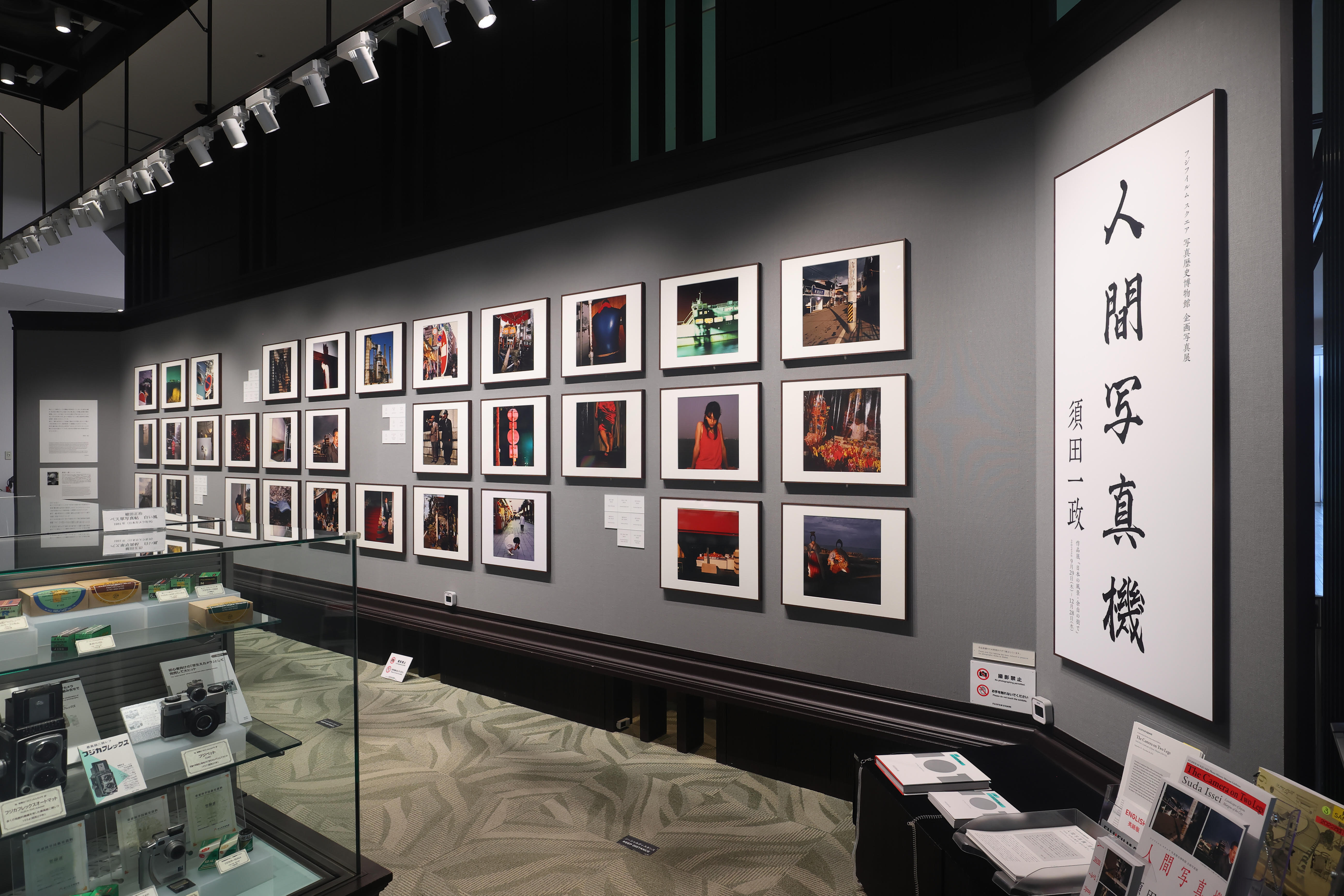
須田氏はモノクロームの写真家として知られていますが、1979年から1990年代にかけてカメラ雑誌に掲載されたカラー写真シリーズも魅力的な資料として残されています。今回、東京ミッドタウンにあるフジフイルム スクエア写真歴史博物館で開催している、人間写真機・須田一政 作品展「日本の風景・余白の街で」では、そのような須田氏のカラー作品が展示されています。「満足度」が溢れる展示です。
このシリーズは、1982年から1986年にかけて日本各地で撮影されたもので、1986年に銀座の富士フォトサロンで43点が初公開されました。2022年の展示では新たにラムダカラープリントされた32点が展示されています。 このプリント方法は、須田氏の精密なカラーポジフィルムによる豊かな色彩をそのままに、特にバターのように濃厚な赤が生き生きと深く輝いています。
展示の壁に近づいていきましょう。
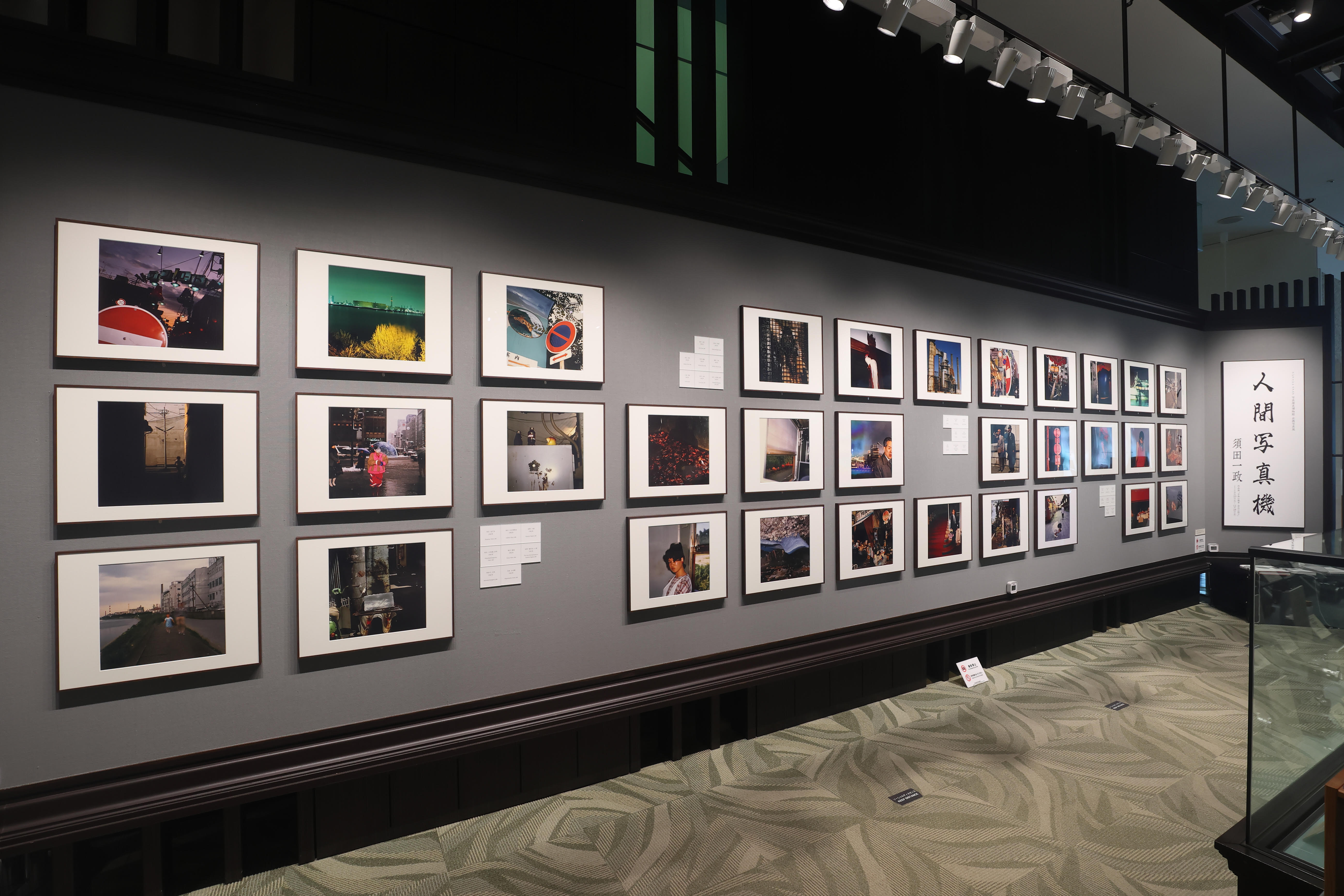
まず遠くから見たとき、まとまりのある美しさに目を奪われました。膝にのせる写真集と違って、このように多くの写真を見ることができるのはやっぱり貴重な体験です。「写真はプリントだ!」ということをあらためて感じられます。
数メートル離れたところに立つと、パネルの配列に引き込まれます。一枚一枚をじっくり見ていくと、須田氏の写真は日常世界の表層を超えたところにあるように見え、フジフイルム スクエアのテキストに書いてある「二重の現実」を垣間見ることができます。 どの写真も見れば見るほど非日常的なのです。
さて、今回発表されている写真は何なのかというと、 これらはすべて間違いなく須田氏の代表作です。活気に満ちた道路標識の数々、奇妙な並置、何かに注視したり考え込んだりしている人々の表情、そして不思議なほど魅力的な路上のゴミ。空き瓶と半分食われて残されたリンゴがどうしてこんなに面白く感じられるのでしょう。
人間も写っていますが、中国風の赤いドレスを着て階段を登っている女性の写真以外、ほかの作品はすべて静止の瞬間をとらえています。
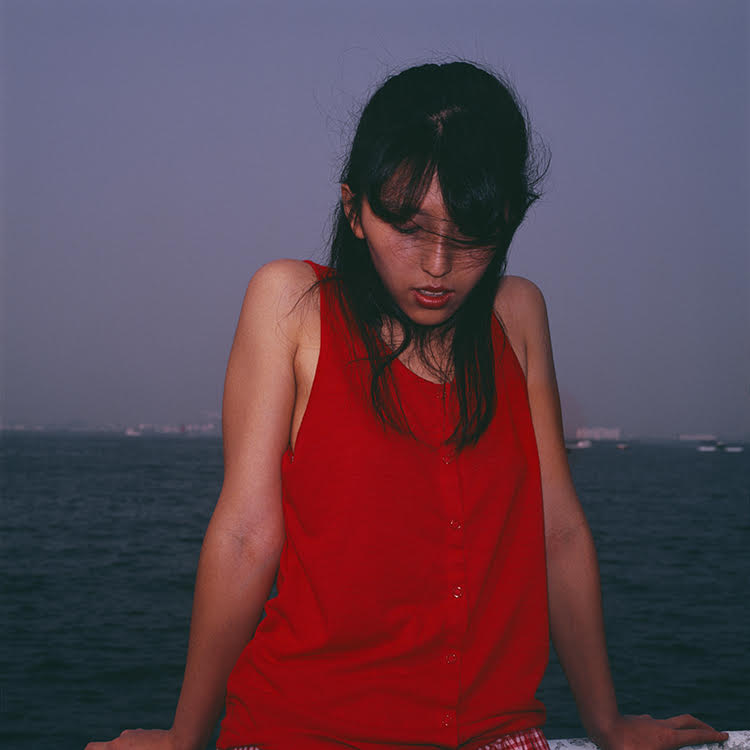
撮影地不詳 1982-1983年 ©︎SUDA ISSEI Works
浅草で横向きにしゃがんでローアングルで撮影している女性や、海辺で身を乗り出している赤トップスの女性が写っていても、中間的で、非アクションの頂点にいることがわかるのです。 写真の次に何が来るのかが全く示唆されないそれぞれの瞬間は、その正方形に留められた時間において完璧であるため、この形で存在しているのだと感じられるのです。
須田氏の興味はレンズの前の被写体だけにとどまらず、「写真」というメディア(魔法?)そのものへの興味を強く感じられます。須田氏の写真は、人間の目には映らない時間の変化との駆け引きの深さを示しています。
これには、フラッシュや、時には長時間露光を使った崇高な表現も含まれます。このような人間が見えない領域が、素直なアプローチで作られたイメージの中にさりげなく混じっているのです。4月の桜の花びらやブルーシートの揺らめきに、緩急をつけた時間の使い方、現実が非現実を示唆するような写真を撮っていたのです。須田氏の作品に見られる不思議な輝きは、本来「普通」であるはずのものが、ほんの少しだけ「普通」でなくなることに、私たちが意味を見出そうとすることで生まれるものでもあるのです。
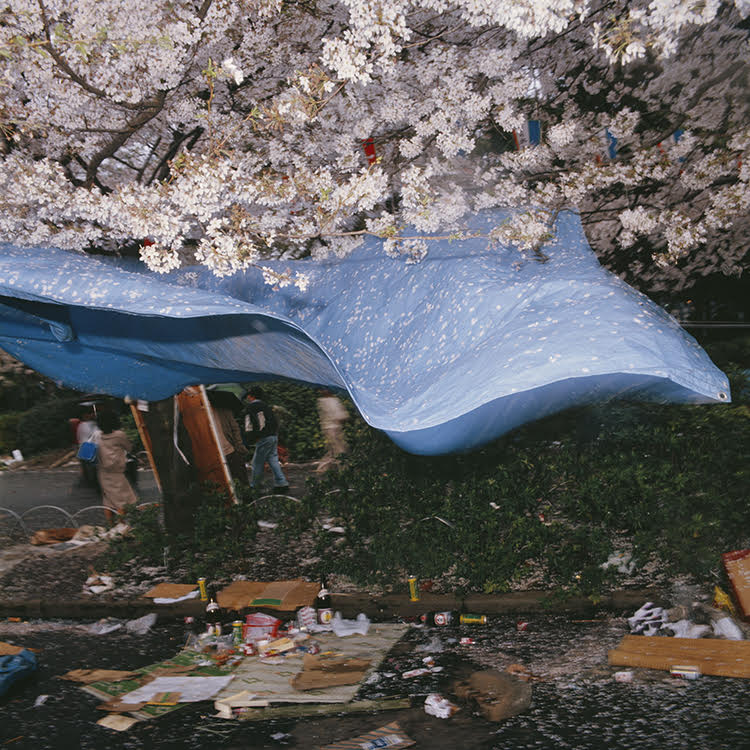
東京・上野 1982年 ©︎SUDA ISSEI Works
本展のサブタイトルにあるように、都市環境の「余白」を撮影したもので、その余白は地理的なものというよりは、精神的なものです。須田氏の写真に写ってる世界と、私たちがこの世界に抱く期待や気持ちとの間にあるギャップが、作品を動かしているのかもしれません。
富士フイルムのウェブサイトに掲載されている展覧会ステートメントに、こんな素敵な一節があります。
- 四六時中、写真のことを考え、撮り続けていた須田は、片時もカメラを手離すことなく街を歩き、無遠慮に、まるで脊髄反射のごとくシャッターを切り続けました。その有り様は、もはや職業としての写真家の姿ではなく、写真に取り憑かれ、身体ごとカメラに化した「人間写真機」さながらでした。
須田一政がガイドなのか探検家なのか、最初は判断に迷います。でも「ガイド」というのは、予測可能な見どころを計画的に巡ることを意味します。須田氏が伝統的でない光と時間のバランスを用いることで明らかになったリスクを考えれば、彼がメディアを探求していることを示唆し、彼とカメラが現実から切り撮ったものに私たちは間違いなく魅了されているのです。
写真家にとって、このアプローチが軌道に乗るということは、単なる楽しみを超えて個人的な意味の探求へと深化していきます。撮影、編集、プリント、見るという「写真道」のループは、写真の魔法にかかった人に、世界と向き合うための糧を与えてくれるのです。須田氏のようにカメラを片手に世界の片隅で、ずっと撮り続けていたいと思います。
「人間写真機・須田一政 作品展」は、一見の価値がある展覧会で、私はこの原稿を書いている時点で、すでに2回足を運んでいます。2022年12月28日まで開催されているので、また何度か足を運ぼうと思っています。ぜひ見てください。
写真提供=フジフイルム スクエア
- 人間写真機・須田一政 作品展「日本の風景・余白の街で」
- 会期:2022年9月29日(木)~12月28日(水)
- 10:00〜19:00(最終日は16:00まで、入館は終了10分前まで) 会期中無休
- 会場:フジフイルム スクエア 写真歴史博物館
- 〒107-0052 東京都港区赤坂9丁目7-3 東京ミッドタウン・ウェスト1F
- The Camera on Two Legs
- Suda Issei:Landscapes of Japan, Margins of the City
- FUJIFILM SQUARE Photo History Museum Photo Exhibition
- September 29 – December 28, 2022
- PHOTO HISTORY MUSEUM
 Vol.41 中嶋琉平|Ryuhei Nakashima「Asia, New York, and Tokyo」、高地二郎|Jiro Kochi「GINZA: Through the eye of a Salaryman 1950-1990」
2025/11/08
Vol.41 中嶋琉平|Ryuhei Nakashima「Asia, New York, and Tokyo」、高地二郎|Jiro Kochi「GINZA: Through the eye of a Salaryman 1950-1990」
2025/11/08
 Vol.40 藤岡亜弥|Aya Fujioka「Life Studies」、荒木塁|Lui Araki 「Color/Scape」
2025/10/03
Vol.40 藤岡亜弥|Aya Fujioka「Life Studies」、荒木塁|Lui Araki 「Color/Scape」
2025/10/03
 Vol.39 榎本八千代|Yachio Enomoto「家族写真 / Family Photo」
2025/09/05
Vol.39 榎本八千代|Yachio Enomoto「家族写真 / Family Photo」
2025/09/05

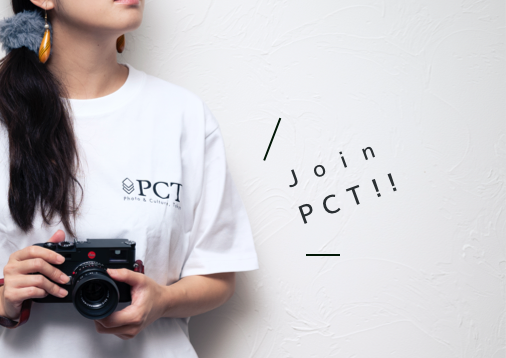
PCT Membersは、Photo & Culture, Tokyoのウェブ会員制度です。
ご登録いただくと、最新の記事更新情報・ニュースをメールマガジンでお届け、また会員限定の読者プレゼントなども実施します。
今後はさらにサービスの拡充をはかり、より魅力的でお得な内容をご提供していく予定です。
 「Photo & Culture, Tokyo」最新の更新情報や、ニュースなどをお届けメールマガジンのお届け
「Photo & Culture, Tokyo」最新の更新情報や、ニュースなどをお届けメールマガジンのお届け 書籍、写真グッズなど会員限定の読者プレゼントを実施会員限定プレゼント
書籍、写真グッズなど会員限定の読者プレゼントを実施会員限定プレゼント